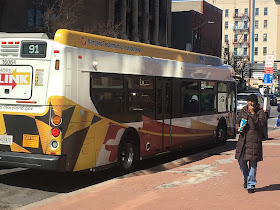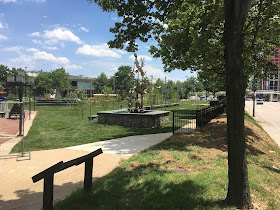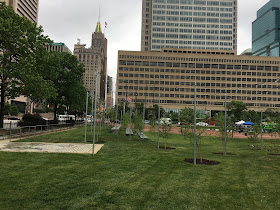 |
| First page headline: Towson gas station |
A big storm cloud is now forming over the County's government seat because the fate of the very controversial mega gas station planned at Towson's norther gateway appears to be in jeopardy years after it seemed like "a done deal".
- Will the County Council really pull the plug on the unloved project pushed forward by County Executive as a Planned Unit Development?
- Will the communities who opposed the proposed mega gas station at every turn for once get a win?
- Will the Council adhere to the cherished principle of councilmanic courtesy in which all refer to the will of the district representative in matters just affecting one district or say good bye to it when it is applied in reverse to revoke a vote.
- Will the Council take the fairly unusual step of aborting a PUD?
- Or will the majority Democratic council reject the lead of Republican council member Marks and vote for a deeply unpopular project to please Executive Kamenetz?
 |
| Proposed development per a developer rendering published by the Sun |
The Royal farm complex with its mega gas station cannot be done under existing zoning because it prudently does not include gas stations as a permitted use south of Bosley Avenue. (There are plenty of gas stations beginning south of the bypass road.PUDs are supposed to allow better development, usually by unifying zoning across several parcels. A PUD for a single parcel is already an abuse of the original intent of PUD as a planning tool but has become typical in City and County in part because the underlying zoning codes were or are antiquated. (The City just adopted a new code which is supposed to cut back the number of PUDs).
Rumors about Marks reconsidering his initial stand circulated in Towson since the beginning of June.
As early as 2013 the Council had also approved a land swap in which the County would sell its fire station lot at York and Bosley, build a new station and still have money left from the sale, even
 |
| The site with the old fires tation and its trees before demolition (Google Earth) |
Second in line of the submitted proposals was a Royal Farm cum gas station project which Towson communities have opposed from the beginning as a very poor "Gateway" (the name of the project) into Towson. To this day the land sale has still not been fully executed. Residents became extra incensed when the County recently denuded the site of mature trees in a surprise action which County officials described as "cleaning up the site in preparation of the sale of the site" without that the PUD had gone through all approval steps. A step that Republican councilman Wade Kach calls a "direct violation of the PUD" because stipulations of the Council that the trees should be preserved were part of the PUD as introduced.
Mega gas stations under the banner of Royal Farms, Marathon, Sheetz or the like (depending on which region in the US one considers) have become a menace to good urban design and mar communities across the country in the same way as the endless proliferation of corner drugstores under the CVS, Walgreens and Rite Aid flag. These uses create far higher revenues than most other projects and they all have a car-centric standard layout and design template that usually trumps local design reviewers or planning commissions.
 |
| Eye level view of the proposed Royal Farms project (Developer rendereing) |
Because of the significance of Councilman Mark's action I asked him a number of questions. Here the full interview:
Q: What exactly made you change your mind regarding the merits of this project?
From the beginning, I supported the review of the project and not necessarily the project itself. There is a difference. I always had concerns about the project, but hoped that the developer might be able to accommodate the community's issues. Regretably, since the County Council passed the resolution in December allowing further review of this project, things have actually moved backward. The turning point, for me, was the decision by the County Executive's staff to destroy 30 mature trees in clear violation of the County Council's mandate. That was appalling and indefensible.
Ultimately, I withdrew my support for continuing the review because there was no public support, and because I do not want this project to be embroiled in litigation for the next few years.
 |
| Community protest against the Royal Farms project |
Q: Do you fear that this would set a precedent in which developers can lose trust in the PUD process if it can be ended without that the project parameters really changed?
The PUD process is supposed to emphasize public input and collaboration. The lesson here is that smart developers should embrace those concepts if they want to take advantage of the PUD process. Caves Valley Partners has done some good projects, but in all candor, this was not their finest work.
Q: What do you think about the principle of council-manic courtesy? Is it still something that should guide the council even on larger prominent issues? What speaks for and what against it in your opinion?
I have consistently supported Councilmanic courtesy, and I hope my colleagues will honor this tradition that stretches back for more than three decades. That tradition generally works. If we did not have Councilmanic courtesy, you could have a situation where four Council members might override the district representative, and the voters would have no way to hold those four other Council members accountable. We each know our own districts.
I have outlined numerous reasons why the process for this PUD is tainted--most prominently, the destruction of the trees, which removed a key hurdle for the developer. I am asking my colleagues to look at the process.
Q: What are the chances of finding a better project for the site? The Royal Farm wasn't the first choice anyway, it was selected after the initially preferred project withdrew.
Let's be honest--nothing will be approved here without community support. We have another PUD in Towson, 101 York, that is of far higher quality but has been appealed for years because there is community opposition. If the county re-bids this property, I have no doubt that a higher quality proposal would be found for this valuable piece of real estate.
We are nearing the end of the Kamenetz administration. While the County Executive talks about revitalizing Towson, it was the County Council that did much of the heavy-lifting on key legislation that supported a lot of our redevelopment projects. And it was the County Executive who blocked initiatives, such as a circulator, that a more progressive leader would realize is needed in Downtown Towson. I am looking forward to that new leadership next year from the County Executive's office.
Community Architect Daily: Thank you!
It remains to be seen whether this cloud formation will rain on the upcoming Towson Fourth of July parade or actually further community cohesion.
Recent Baltimore Brew article about councilmanic courtesy












































